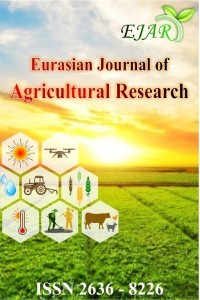Determination of Morphological Characteristics of the Wetland Sediments Inekli, Azapli and Golbasi Lakes in the Eastern Mediterranean Region
Determination of Morphological Characteristics of the Wetland Sediments Inekli, Azapli and Golbasi Lakes in the Eastern Mediterranean Region
Golbasi Depression, wetland soil, morphological property,
___
- Abacı Bayan A.A. 2016. Soil characteristics, efficiency levels and problems of wetlands in the eastern mediterranean region. Kahramanmaraş Sutcu Imam University, Institute of Science, Department of Soil Science and Plant Nutrition, Doctorate thesis. Akdemir İ. O. 2004. GolbasiIlcesinin (Adiyaman) Human and Economic Geography, PhD Thesis, Fırat University, Institute of Social Sciences, Geography Department. Altunbaş S. Sarı M. 2011. Relations Between Some Physical Properties and Production Potentials of Soils Gained from Dried Kestel Lake, Akdeniz University, Journal of Agricultural Faculty, 24(1):61-65. Biricik S.A. 1994. “Gölbaşı Depression". Turkish Geographic magazine Issue:29, İstanbul. pp:53-8. Ministry of Environment, Right Environment for the year 2000. TBMM Environment Research Commission Report (10-15) Ankara.
- Demiralay İ. 1993. Soil Physical Analysis. Atatürk University Agricultural Faculty Publications No: 143, pp: 131, Erzurum.
- Foy C. D. 1992. Soil chemical factors limiting plant growth. In: J. L. Hatfield and B. A. Stewart (eds.), Limitations to Plant Root Growth. Adv. Soil Sci. 19:97-149.
- Sari M., Altunbas S., Sonmez N. K. & Emrahoglu I. 2003. Properties and Potential Productivities of Old Manay Lake Area Soils on Different Physiographic Units. Akdeniz University Journal of Agricultural Faculty, 16: 7-17.
- Sari M., Altunbas S. & Yildiran M. 2000. Determination of the Characteristics of the Wastes from the Kestel Lake Area Driven in the Lakes Region The Ministry of Environment, General Directorate of Environmental Protection Research Report, Ankara.
- Soil Survey Manuel. 1993. Soil survey manual. USDA handbook No. 18. Washington, USA.
- Master Plan. 2004. Ministry of Agriculture and Welfare, Project for the Preparation of Provincial Agriculture and Rural Development Master Plans, Adiyaman Agriculture Master Plan, December.
- Thomas G.W. 1996. Soil pH and Acidity. pp:475-491. In D.L. Sparks (ed) Method of Soil Analysis: Chemical Methods. Part 3. SSSA, Madison, WI.
- Tuzuner A. 1990. Soil and Water Analysis Laboratories Manual. Republic of Turkey Ministry of Agriculture, Forestry and Rural Affairs General Directorate of Rural Services. pp:21- 27.
- Yaras K. & Dasgan H. Y.2012. The Effect of Micronize-Bentonite-Sulfur and Organic Matter Applied to Soil in Greenhouse Conditions on Soil pH, Tomato Plant Growth, Yield and Fruit Quality. Agricultural Science Research Journal 5 (1): 175-180.
- Jackson M. L. 1992. Soil Chemical Analysis, Prentice-Hall Inc, 183.
- ISSN: 2636-8226
- Yayın Aralığı: Yılda 2 Sayı
- Başlangıç: 2017
- Yayıncı: Muhammed Cüneyt BAĞDATLI
Flaming and Burning as Thermal Weed Control Methods: A Review
Ali BOLAT, Ugur SEVILMIS, Ali BAYAT
The Performance Assessment in Irrigation Systems: The Case of Turkey
Mehmet Akif KALENDER, Ramazan TOPAK
The Evaluation of Active Green Sites For Recreation: Bor Case
Gülden SANDAL ERZURUMLU, Nuriye Ebru YILDIZ, Barış KAHVECİ
Ahu Alev ABACI BAYAN, Kadir YILMAZ
A New Approach in Management Against Plant Fungal Disease: Host Induced Gene Silencing
A Software Development for Real Time Spray Control System in Herbicide Application
Ömer Barış ÖZLÜOYMAK, Ali BOLAT, Ali BAYAT, Emin GÜZEL
The Evaluation of Kayseri, Ağırnas Traditional Houses in the Frame of Ecological Design
Elmas ERDOĞAN, Nuriye Ebru YILDIZ
